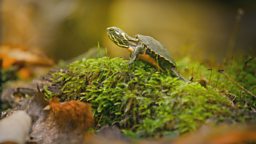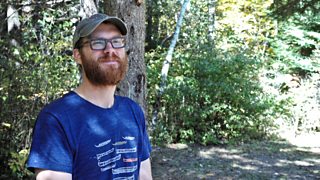Why did the turtle cross the road?

Of the six characters featured in Big Little Journeys, the painted turtle hatchling is the smallest – only the size of 10p.

To film such a tiny animal the team worked with Dr Patrick Moldowan from the University of Toronto. He is part of a project that has been studying and tracking painted turtles in Algonquin Provincial Park for more than 50 years.
It's the world’s longest and most continuous study of turtles so Patrick and his team know everything that these tiny reptiles get up to on their journeys from the nesting ground to the safety of a wetland.
They discovered only 1% of hatchlings make it to adulthood – such is the danger that awaits them at every turn.
Here Patrick gives an insight into his work and the challenges that these endearing reptiles face…
How do you identify a painted turtle?

‘Turtles are instantly recognizable because they have that armour, that amazing shell. But painted turtles have beautiful red streaks. It’s like somebody has taken a very fine paintbrush and painted their beautiful striping and patterns.’
What’s special about studying painted turtles?
'Our focus has a lot to do with something called ‘turtle life history’, which includes crucial information such as how many young they produce, do they care for those young, how long do they survive, and how do they age? In the case of turtles, it's crucial to study them for a long time because they are very long lived.’
‘You truly can't know about the biology of these animals unless you study them through the entirety of their lifespan. The Algonquin Wildlife Research Station has studied here since 1972, in fact, half a century, and we still have turtles that started in the study that are alive with us today.’
What are their threats?

‘Painted turtles are bite sized for a lot of things. They’re timid and their shell is very soft when they've just hatched. Red foxes, ravens, raccoons, and skunks exist at high population densities. They readily dig up the nest. There are some places here in Ontario where there's over 90 to even 100% nest mortality.’
Why do turtles have to cross the road?
‘It is not only Canadian giants, like black bears, that these walnut-sized turtles must watch out for. In 1960, highway 60 was built straight through Algonquin park, and since then its sandy slopes have become turtle nesting grounds.’
‘Females are often attracted to roadsides to lay their eggs, especially in a landscape like this where there's so much forest, nesting habitat is really limited but the roadsides provide a gravel sand mixture. It’s extremely dangerous because they can be struck and killed on roadways.’
How are they being affected by climate change?

'There’s an increasing concern that global climate change could skew the sex ratios. Females lay their eggs around early to mid-summertime, and the eggs take about 70 to 90 days to develop the embryos, developing at a rate that coincides with temperature. You get a 50:50 ratio of males and females at intermediate temperatures. Warmer temperatures tend to lead to faster development, but also leads to more females, and less males being produced, and this could have a huge impact on the survival of the population.'
Discover how the tiny painted turtle hatchling travels through rich deciduous forest against all odds, in Episode 1 of Big Little Journeys on Sunday 8th October at 8pm.
